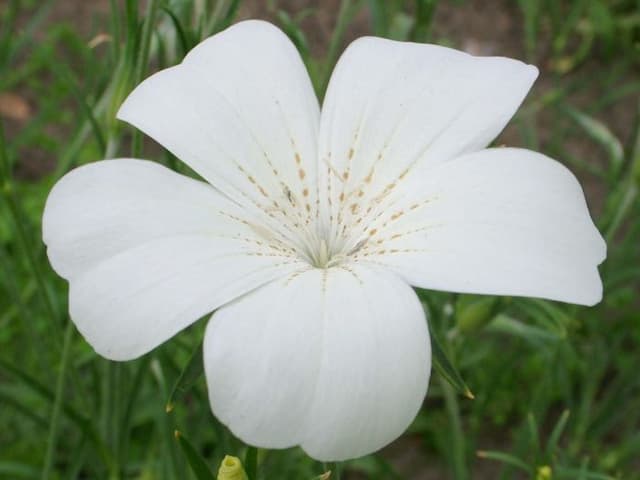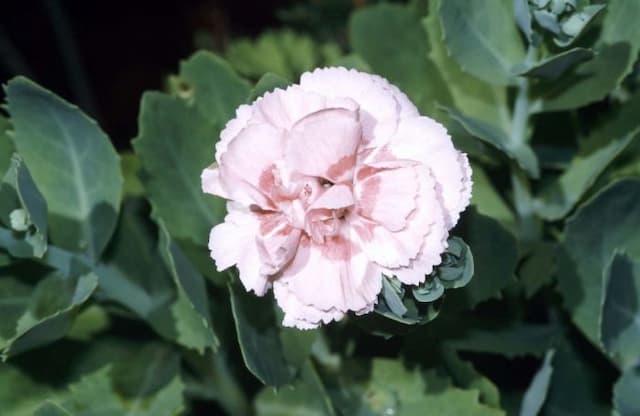Carnation Dianthus 'Rose Monica Wyatt' (p)

ABOUT
Dianthus 'Rose Monica Wyatt' is a plant that is notable for its striking and vibrant flowers. The blooms exhibit a vivid rose-pink hue that can add a splash of color to any garden setting. These flowers are often quite full and rounded, appearing like a classic, cottage-style small flower with frilly or serrated edges that give them a somewhat lacy appearance. The petals can sometimes show a lighter or even white fringing, which highlights their shape and adds to their visual appeal. The leaves of Dianthus 'Rose Monica Wyatt' are typically slender and elongated with a grayish-green to blue-green color, which provides a lovely contrast to the bright flowers. The foliage has a dense, grass-like quality, forming a tuft or mound that cradles the flowers above. The overall impression of 'Rose Monica Wyatt' is one of old-fashioned charm and delightful color, capable of bringing a warm and inviting aesthetic to gardens or landscapes where they are planted. The plant's flowers are also known for emitting a delightful fragrance, which can vary in intensity but often has spicy or clove-like undertones, making it a treat for the senses.
About this plant
 Names
NamesSynonyms
Rose Monica Wyatt Dianthus, Carnation, Pink
Common names
Dianthus 'Rose Monica Wyatt'
 Toxicity
ToxicityTo humans
Generally, the Dianthus species, commonly known as Carnation, is not considered toxic to humans. However, as with any plant, individual reactions can vary, and it's always prudent to avoid ingesting parts of ornamental plants due to the potential for stomach discomfort or allergic reactions. There are no well-documented cases of poisoning from Carnations in humans, and they are not typically associated with severe toxicity. If ingested, mild gastrointestinal upset may occur.
To pets
Carnation is generally regarded as non-toxic to pets, including cats and dogs. It's not known to cause serious poisoning if pets consume small quantities of the plant. However, just like with humans, ingestion can potentially lead to mild gastrointestinal upset, such as nausea or vomiting. As a precaution, it's always best to prevent pets from eating ornamental plants.
 Characteristics
CharacteristicsLife cycle
Perennials
Foliage type
Evergreen
Color of leaves
Blue-green
Flower color
Pink
Height
1 foot (30 cm)
Spread
1 foot (30 cm)
Plant type
Herb
Hardiness zones
7
Native area
Europe
Benefits
 General Benefits
General Benefits- Enhances Garden Aesthetics: Adds color and texture to garden beds with its vibrant flowers and dense foliage.
- Attracts Pollinators: Invites beneficial insects such as bees and butterflies, supporting local ecosystems.
- Long Blooming Period: Offers extended visual interest with a lengthy flowering season.
- Low Maintenance: Requires minimal care once established, making it ideal for busy gardeners.
- Drought Tolerance: Survives in dry conditions once established, reducing the need for frequent watering.
- Hardy Growth: Adaptable to a range of soil types and environmental conditions, ensuring robust growth.
- Cut Flower Use: Produces attractive blooms suitable for bouquets and floral arrangements.
- Edging and Borders: Ideal for creating defined lines and edges in garden design.
- Compact Size: Well-suited for small gardens or spaces where a smaller-scale plant is desired.
 Medical Properties
Medical PropertiesThis plant is not used for medical purposes.
 Air-purifying Qualities
Air-purifying QualitiesThis plant is not specifically known for air purifying qualities.
 Other Uses
Other Uses- Cut Flowers: Dianthus 'Rose Monica Wyatt,' commonly known as Carnation, is frequently used for its long-lasting blooms in cut flower arrangements.
- Edible Decor: The petals of Carnations can be used as an edible garnish for salads, desserts, and drinks, adding color and a mild spicy flavor.
- Artistic Dye: Carnation petals can be used to create natural dyes for fabric or paper, yielding shades of pink to purple depending on the concentration and type of mordant used.
- Perfume Industry: The fragrance of Carnations is captured in essential oils and used as a scent in perfumes and scented products.
- Craft Projects: Dried Carnation flowers can be incorporated into craft projects such as homemade potpourri, bookmarks, or greeting cards.
- Culinary Infusion: Carnation petals can be infused into syrups or sugars to impart a subtle flavor in gourmet culinary creations.
- Victorian Language of Flowers: Carnations can be used to send messages according to the Victorian language of flowers, where each bloom represents a different sentiment.
- Symbolic Gifts: In some cultures, Carnations are a traditional Mother's Day gift or used in ceremonial events like weddings and funerals for their symbolism and beauty.
- Teaching Tool: The variety of colors and easy cultivation of Carnations make them a good plant for educational purposes in horticulture or botany classes.
- Botanical Illustration: Carnival flowers, with their intricate petals and vibrant colors, are often chosen as subjects for botanical illustration and study by artists.
Interesting Facts
 Feng Shui
Feng ShuiThe Carnation is not used in Feng Shui practice.
 Zodiac Sign Compitability
Zodiac Sign CompitabilityThe Carnation is not used in astrology practice.
 Plant Symbolism
Plant Symbolism- Love: The genus Dianthus is often associated with love and affection, stemming from its historic use in Greek and Roman times for decorative and ceremonial purposes.
- Admiration: With its bright colors and pleasant fragrance, Dianthus flowers like 'Rose Monica Wyatt' can symbolize admiration for someone's beauty and grace.
- Boldness: The 'Rose Monica Wyatt' variant, with its striking appearance, may represent boldness or daring, exuding confidence through its vivid blooms.
- Devotion: Dianthus has a long-standing association with commitment and loyalty, making it a fitting symbol for deep and enduring devotion in relationships.
- Purity: The clarity and simplicity of the flower's design have often led to it being linked with purity and innocence.
 Water
WaterPinks, including the Dianthus 'Rose Monica Wyatt', should be watered thoroughly when the soil feels dry to the touch, usually around once a week. However, it's essential to avoid overwatering as these plants prefer drier conditions. Apply water directly to the base of the plant to keep the foliage dry and prevent fungal diseases. During the growing season, you might need to water the pinks every few days especially if the weather is particularly hot or dry. As a general rule, aim for about one inch of water weekly, which equates to approximately 0.623 gallons for a square foot of soil.
 Light
LightPinks, such as the Dianthus 'Rose Monica Wyatt', thrive best in full sun conditions, where they receive at least six hours of direct sunlight each day. They perform well in a spot that enjoys bright and unfiltered sunlight for most of the day. Be sure to locate your pinks in a sunny border or in a container placed in a south-facing position to ensure they get sufficient light for optimal growth and flowering.
 Temperature
TemperaturePinks, like Dianthus 'Rose Monica Wyatt', generally prefer cooler temperatures and can tolerate a range from about 40°F to 80°F. They can survive brief dips below freezing, but prolonged exposure to temperatures under 40°F may be harmful, especially if the ground is wet. The ideal temperature range for these plants is between 60°F and 70°F. They should be protected from extreme heat, as temperatures consistently above 80°F can stress the plant.
 Pruning
PruningPinks, including Dianthus 'Rose Monica Wyatt', benefit from pruning to promote bushy growth and to remove dead or spent blooms, a practice known as deadheading. Prune after the first bloom in late spring or early summer to encourage a second flush of flowers. Trim back the foliage by one-third to one-half, ensuring you make cuts just above a set of leaves or a growth node. The best time for pruning is usually after the main blooming period has finished.
 Cleaning
CleaningAs needed
 Soil
SoilThe best soil mix for Dianthus, commonly known as Pinks or Sweet William, should be well-draining and loamy with a slightly alkaline pH between 7.0 and 7.5. A mixture of garden soil, compost, and gritty material like perlite or coarse sand is ideal for promoting good root health and drainage.
 Repotting
RepottingDianthus, or Pinks, generally do not require frequent repotting and can be repotted every 2-3 years or when the plant has outgrown its current container. Ensure that the new pot has adequate drainage holes.
 Humidity & Misting
Humidity & MistingDianthus, also known as Pinks, prefers moderate humidity levels but is quite adaptable and can tolerate a range of humidity conditions. It's not necessary to maintain specific humidity levels for Dianthus.
 Suitable locations
Suitable locationsIndoor
Place Pinks near a sunny window; water when soil feels dry.
Outdoor
Plant Pinks in full sun and well-draining soil.
Hardiness zone
3-9 USDA
 Life cycle
Life cycleThe Sweet William 'Rose Monica Wyatt' begins its life as a seed, typically sown in late winter to early spring under cover or in early autumn. Upon germination, it develops a small rosette of leaves that establish themselves as it enters the vegetative stage. Over time, the rosette grows larger, and the plant starts to develop a stronger root system. Once mature enough, usually in late spring or early summer, it initiates the flowering stage, producing clusters of fragrant blooms that can range in color depending on the variety. After pollination, often by bees or butterflies, the plant sets seed, which can be collected once the flower heads dry out, completing the reproductive cycle. The plant may then either die off if it’s a biennial or go dormant in the colder months if it’s a perennial, to regrow the next season.
 Propogation
PropogationPropogation time
Spring-Early Summer
Propogation: The Dianthus 'Rose Monica Wyatt', commonly known as pinks, is best propagated through stem cuttings, particularly in late spring or early summer when the plant is actively growing. To propagate, a gardener should select a healthy, non-flowering stem and cut a 4 to 6-inch (about 10 to 15 cm) length, ensuring that a few leaf nodes are included. The lower leaves are removed, and the cut end may be dipped in rooting hormone to encourage root development. Then, the cutting is placed in a well-draining soil mixture, typically composed of equal parts perlite and peat moss. The cutting should be kept in a warm environment with indirect sunlight and high humidity, often achieved by covering the pot with a plastic bag or placing it in a propagator, until roots have established, which usually takes several weeks. Once the cutting has rooted and shows signs of new growth, it can be transplanted into a permanent location.








![Pink [Bubblegum]](/_next/image?url=https%3A%2F%2Fplants-admin.emdemapps.com%2Fimages%2Fplants%2F%2Fimages%2F604b596f31cbb.png&w=640&q=75)
